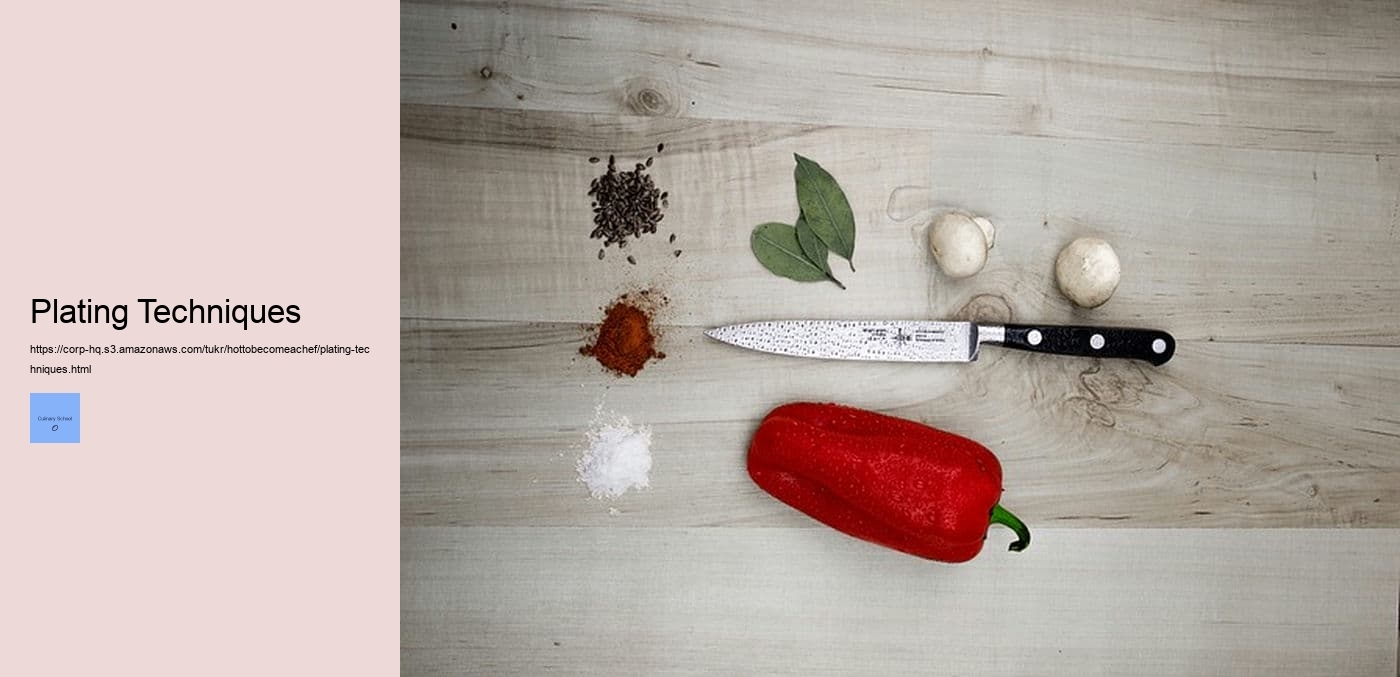

Introduction to Plating Techniques!
Plating is a process which involves coating metal surfaces with a thin layer of another material, often for decorative or protective purposes. As you advance in your culinary career, focus on developing your own unique cooking style and specialty dishes that showcase your talents. Recipe Development Cooking competitions. Many chefs choose to compete in cooking competitions to gain exposure for their skills and business ventures. Recipe Development Food safety practices. As you advance in your culinary career, focus on developing your own unique cooking style and specialty dishes that showcase your talents. How to become a chef Kitchen experience. As you advance in your culinary career, focus on developing your own unique cooking style and specialty dishes that showcase your talents. How to become a chef Culinary school. There are many different plating techniques used around the world, some of them being electroplating, electroless plating, and physical vapor deposition (PVD).
Electroplating is one of the oldest and most common forms of plating. This technique uses electric current to deposit metal onto the surface of an object. It can be used to add a layer of gold, silver, nickel or other metals with good corrosion resistance. Electroplasting also allows for custom designs and shapes to be created on objects.
Another plating method is electroless plating, which uses chemicals instead of electricity to coat an object in metal. This process is more advantageous than electroplasting as it eliminates any risk of electrical shock and has fewer environmental impacts due to its use of non-polluting chemicals. Furthermore, this technique does not require any masking tape or patterns making it simpler than other methods.
Finally, PVD is a deposition process which utilizes vacuum technology in order to apply metals such as titanium nitride onto surfaces in order to improve their durability and longevity. This method produces a stronger bond between the substrate and coating than traditional methods do as well as providing superior wear protection from abrasion and corrosion; however, it does have higher production costs associated with it compared to other techniques.
In conclusion, there are several ways to plate surfaces depending on what kind of look you want for your project or product. With careful consideration given towards cost versus performance needs one can select the best option for their application; however all three processes discussed here provide excellent results that will last through years of use!
The choice ultimately lies with you - no matter what your requirements may be - when deciding which plating technique works best for your situation!

Plating techniques are a great way to add beautiful decoration and protection to metal surfaces. There are (many) types of plating techniques, each with its own advantages and disadvantages. Electroplating is the most common type of plating technique, involving the application of an electrical current to a metal surface. This process creates a thin layer of metal on the surface which provides corrosion resistance and decorative effects. Anodizing is another popular form of plating, where an acid bath is used to create a protective oxide coating on the metal surface. This method gives a variety of colors that can be used for decorative purposes or as part of industrial applications such as aerospace engineering.
Galvanization is a (relatively) old-fashioned plating technique, but one that still has its uses today. It involves using zinc to protect steel from corrosion in order to prevent rusting or wear and tear over time. Powder coating is another popular plating method that involves spraying particles onto the surface which then melt when exposed to heat, creating a hard coating that helps protect against weathering, wear and tear as well as providing excellent decorative effects! Finally, electroless plating requires no electricity like electroplating; instead it uses chemicals deposited into liquid baths in order for them to adhere onto metal surfaces creating strong coatings for protection against corrosion and aesthetic appeal.
In conclusion, there are many different types of plating techniques available depending on what you need for your particular project – some offer more protection while others give better decorative results! Whatever you choose though, you're sure to get quality results from these amazing processes!

Becoming an award-winning chef takes a lot of hard work and dedication.. It's not enough to just be able to cook well, you have to also be passionate about the craft and have the drive to succeed.
Posted by on 2023-09-03

The steps necessary to achieve one's dream of becoming a professional chef are multifaceted and require dedication (and some luck!).. Firstly, it is important to pursue educational opportunities in the culinary field.
Posted by on 2023-09-03
Plating techniques offer many advantages!(For starters,) they can help improve the lifespan of materials, by providing a protective coating layer that prevents degradation and corrosion. Plating also adds to the aesthetics of items, as it can give them a shiny finish or an attractive color. It may even improve the performance of components by increasing their conductivity. Furthermore, plating processes are relatively cost-effective and faster than other methods such as painting.
Moreover, plating is used in various industries like electronics and automotive for its anti-friction properties and ability to protect against wear and tear. This enables parts to last longer and perform better with less maintenance required over time. Lastly, plating techniques are versatile; they can be applied on almost any type of substrate, including metal, plastic or ceramics. All these features make it ideal for applications ranging from industrial production lines to household goods!
In conclusion, plating techniques provide numerous benefits which makes them an attractive option for many products. They offer improved durability and performance while also adding aesthetic value at a reasonable cost (and) with minimal effort required. Therefore, it's no surprise that plating is widely employed across numerous sectors!

Plating techniques are widely used to enhance the appearance of metals and other materials. However, there are certain disadvantages associated with these methods as well. Firstly, it can be quite expensive to do plating (especially compared to painting). Additionally, some of the chemicals used in plating can be toxic and hazardous if not handled properly. Another problem is that plating can only be done on relatively flat surfaces which limits its applications. Furthermore, it can also weaken the metal over time due to corrosion or wear and tear! Lastly, since the process involves electrolysis it requires a lot of energy which makes it unsustainable in the long run.
On the whole, while plating techniques can be effective for improving the look and feel of metals, they come with their own set of drawbacks. Therefore, one should always consider these factors before investing in them. Nonetheless, despite its shortcomings plating still remains a viable option for various projects where aesthetics are important. All in all, it is essential to weigh out both advantages and disadvantages before deciding whether this method is suitable for your needs or not.
Process Overview for Different Plating Techniques
Plating is an important process used in many industries such as the automotive, aerospace and medical fields. It involves applying a thin layer of metal to another surface to provide protection or create a desired effect. There are various plating techniques available, each with its own pros and cons. Let's take a look at some of the common ones:
Electroplating is one of the most commonly used methods. This process involves passing an electric current through an electrolyte solution containing dissolved metal ions, which then deposit on the target surface. The primary benefit of electroplating is that it produces highly uniform layers with exceptional adhesion strength. Additionally, this technique can be employed for depositing multiple metals simultaneously!
Immersion plating is another popular option. In this method, the object to be plated is immersed into a tank filled with molten metal or salt solution. As long as there is contact between the object and the liquid, a thin layer of metal will form on it's surface after cooling off. Immersion plating has been known to produce smoother surfaces than other techniques and provides excellent coverage even around complex shapes. (However, it does require specialized equipment.)
Finally, electroless plating stands out from other methods due to its ability to achieve uniform thicknesses across large areas without relying on electrical currents! This technique relies on chemical reactions instead; chemicals are added which cause metal particles suspended in solution to deposit evenly onto the target surface over time. Although more expensive than traditional electroplating processes, electroless plation offers better corrosion resistance and makes it easier to plate difficult-to-reach places like internal cavities and channels.
In conclusion, while all three processes offer unique advantages depending on your needs and budget, you should always consider both cost and performance when choosing which method best suits your project!
Plating techniques are widely used in a variety of applications, from decorative to functional and industrial. These methods involve applying a thin layer of metal or other material to a solid surface, often by electrochemical processes. They can be used for many purposes, such as strengthening objects, creating corrosion resistance, or changing the appearance of the object. (However,) there are several common applications for plating techniques.
First, plating is often used to create a decorative finish on jewelry and other objects. Gold plating is one example; gold gives items an attractive shine that cannot be achieved with any other material. Plated items may also be coated with silver or copper to create unique looks. Additionally, plating is commonly employed in electronics manufacturing to enhance conductivity and protection against corrosion.
Furthermore, plating techniques are applied in the automotive industry for improved vehicle performance. Chrome-plated wheels not only look better than regular ones but also provide added protection against rusting and damage caused by road debris. Similarly, engine parts are often coated with metals such as nickel or zinc for increased durability and strength.
Finally, plated products are even found in the medical field! In hospitals and clinics all over the world plate materials like titanium and stainless steel are utilized for implants and surgical instruments due to their durability and safety properties compared to other materials! Moreover, these materials can withstand extreme temperatures while still being non-toxic!
All in all, these examples demonstrate just some of the common applications of plating techniques available today! From aesthetic finishes on jewelry to medical implants – these processes have truly revolutionized various industries!
Plating techniques have come a long way over the years. In recent times, there has been an increased focus on future developments in plating technologies to help make it more efficient and cost effective. There is much potential for new innovations and improvements in this area.
One of the key areas of current development is the use of green plating processes. This involves using less toxic materials than traditional methods, such as cadmium and cyanide-based plating systems. Such processes are becoming increasingly popular due to their reduced environmental impact and cost efficiency. The goal is to create safer and more sustainable plating products that can be used without causing harm or damage to the environment, while still producing high-quality results.
Another major area of development is nanotechnology. This involves developing nanomaterials which are extremely small particles with unique properties that can be used in various applications within the field of plating technology. These nanomaterials could enable faster deposition rates, improved adhesion strength, or even enhanced corrosion resistance depending on how they are used. Additionally, these materials may also allow for new designs and shapes to be created which would otherwise not be possible with traditional methods!
Furthermore, advances in computer technology are allowing for better control over the plating process itself. Computer controlled systems can now accurately monitor all aspects of the plation process from start to finish - ensuring consistent thicknesses across an entire batch while drastically reducing waste levels at the same time! By utilizing computer control systems, manufacturers can save both time and money by streamlining operations while still achieving high quality results each time they plate an item or component.
(To conclude,) With so many exciting possibilities ahead we can only imagine what new breakthroughs will occur within this ever evolving industry! Platers everywhere should certainly keep their eyes open for any upcoming advancements in order to remain competitive within this highly technological age!
Plating techniques are a great way to add a creative edge to many different objects. They can be used to make jewelry, decorate furniture and even enhance cars! However, there are several factors that must be taken into consideration when deciding on which plating technique to use.
First, the cost of applying each technique should be assessed. Some plating methods may require more expensive materials or labor than others. Additionally, the durability of the plating is also important. How long will it last? Will it require frequent maintenance? These questions must all answered prior to selecting a technique.
Moreover, the type of object being coated needs to be considered as well. Some metals might react differently to certain chemicals used in plating processes; thus altering their appearance and longevity. Furthermore, if an object is going to have regular contact with liquids or other harsh chemicals then its plated coating could corrode over time without proper protection from these elements! Lastly, consider what look you're trying for - matte or shiny? This decision will greatly affect which method you choose.
In conclusion (therefore), before deciding on which plating technique is right for your project it's important to weigh all these options carefully! You don't want an expensive mistake due to lack of research! Do your homework first and get those amazing results you're hoping for!!